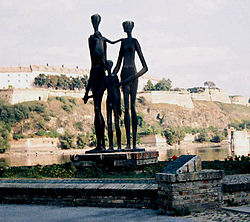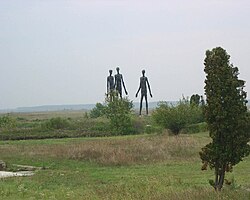This is an old revision of this page, as edited by 84.236.89.208 (talk) at 11:20, 1 April 2007. The present address (URL) is a permanent link to this revision, which may differ significantly from the current revision.
Revision as of 11:20, 1 April 2007 by 84.236.89.208 (talk)(diff) ← Previous revision | Latest revision (diff) | Newer revision → (diff)


The Occupation of Vojvodina (a region in modern Serbia) from 1941 to 1944 was carried out by Nazi Germany, Horthy's Hungary and Independent State of Croatia. During World War II, in 1941, Nazi Germany invaded and occupied Yugoslavia. The Vojvodina region was divided into three occupation zones: Banat was placed under direct German control, Bačka was attached to Horthy's Hungary and Syrmia was attached to the Independent State of Croatia. The occupation lasted until 1944, when the region came under control of the Soviet Red Army and Yugoslav partisans.
Overview
During the four years of occupation, the Axis forces committed numerous war crimes against civilian population: about 50,000 people in Vojvodina were murdered and about 280,000 were arrested, violated or tortured. The victims belonged to all ethnic groups that lived in Vojvodina, but the largest number of the victims was of Serb, Jewish, and Roma ethnicity.
The total number of the people killed by the occupants between 1941 and 1944 in the entire Vojvodina was 55,285, including:
- 18,193 people who were killed directly
- 19,004 people who were sent to concentration camps and killed there
- 4,168 people who were sent to forced labour and killed there
- 3,286 people who were mobilized and later killed
- 10,634 killed members of the resistance movement
Victims in Bačka
The total number of the killed people in Bačka was 19,573, including:
- 6,177 people who were killed directly
- 8,027 people who were sent to concentration camps and killed there
- 2,179 people who were sent to forced labour and killed there
- 1,516 people who were mobilized and later killed
- 1,674 killed members of the resistance movement
Of the total number of the victims (excluding the killed members of the resistance movement), 11,521 were men, 3,768 were women, 1,283 were old people, and 1,327 were children.
Victims in Banat
The total number of the killed people in Banat was 7,513, including:
- 2,211 people who were killed directly
- 1,294 people who were sent to concentration camps and killed there
- 1,498 people who were sent to forced labour and killed there
- 152 people who were mobilized and later killed
- 2,358 killed members of the resistance movement
Of the total number of the victims (excluding the killed members of the resistance movement), 4,010 were men, 631 were women, 243 were old people, and 271 were children.
Victims in Syrmia
The total number of the killed people in Syrmia was 28,199, including:
- 9,805 people who were killed directly
- 9,683 people who were sent to concentration camps and killed there
- 491 people who were sent to forced labour and killed there
- 1,618 people who were mobilized and later killed
- 6,602 killed members of the resistance movement
Of the total number of the victims (excluding the killed members of the resistance movement), 14,484 were men, 3,662 were women, 1,279 were old people, and 2,172 were children.
1942 raid
The most notable war crime was the mass murder of the civilians, mostly of Serb and Jewish ethnicity, performed by some disloyal Hungarian officers (lieutenant-general Ferenc Feketehalmy-Czeidner, major-general József Grassy, colonel László Deák and gendarmarie-captain Márton Zöldi) and their troops raid in southern Bačka. Total number of civilians killed in the raid was 3,808, while places that were affected by the raid include Novi Sad, Bečej, Vilovo, Gardinovci, Gospođinci, Đurđevo, Žabalj, Lok, Mošorin, Srbobran, Temerin, Titel, Čurug, and Šajkaš.
The victims included 2,578 ethnic Serbs, 1,068 Jews, 64 Roma, 31 Rusyns, 21 Hungarians, and 15 Russians.
The responsible officers were arrested, tried and sentenced to death or prison in the same year, but the death sentences could not be carried out as the culprits were abducted by the Germans and taken out from the country. However some Serbian historians tried to prove, that that raid was a well planed plot, and organized by the highest military and political leaders of that time Hungary, including regent Miklós Horthy himself, but despite the fact, that that time and future investigations proved its fallacy, it is still a common idea in the Serbian far right political spectrum.
Notes
- Enciklopedija Novog Sada, Sveska 5, Novi Sad, 1996. (page 196)
- ^ Slobodan Ćurčić, Broj stanovnika Vojvodine, Novi Sad, 1996. (pages 42, 43)
- ^ Ilona Edelsheim-Gyulai: Becsület és kötelesség, part I p.236 (Európa press, Budapest, 2001.) ISBN 963-07-6544-6
- ^ Miklós Horthy: Memoirs p. 235-236 ISBN 0966573439 (PDF)
- Zvonimir Golubović, Racija u Južnoj Bačkoj, 1942. godine, Novi Sad, 1991.
- Zvonimir Golubović, Racija u Južnoj Bačkoj, 1942. godine, Novi Sad, 1991. (page 194)
- Horthy was not tried for any war crimes
See also
- Greater Hungary
- Greater Croatia
- Independent State of Croatia
- Banat, 1941-1944
- 1944-1945 Killings in Bačka
External links
- Carl Savich: Genocide in Vojvodina and Greater Hungary, 1941-1944.
- Hungarian Is Faced With Evidence of Role in ’42 Atrocity
- Chronology of the development of fascism and the anti-fascist struggle of the peoples of Yugoslavia 1941-1945
- Krv je tekla Novim Sadom (in Serbian)